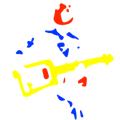Just like individual notes belong in a key, so do the chords they make together.
Before you start
We're getting towards the end now so you'll really struggle if you don't understand:
- the structure of the major scale.
- how chords are built.
- what intervals are and how to name them.
The lesson
Just ilke we can bunch a stack of notes together and call them a scale because we like the way they interact with each other, we can use these same notes to build chords that all work together too. The most common scale that we do this with is, you guessed it, the major scale. We'll see how that works here and you can apply the theory to other scales if you like, jazz guys like to harmonise the harmonic minor scale for example.
We'll use the C major scale as an example because there no sharps or flats. It has seven notes, namely C, D, E, F, G, A and B. The first, third and fifth notes make up a C major chord so the first chord in the C major scale is a C major chord. If we then add the 7th note as well we have C, E, G and B and call it a C major seventh chord.
The second chord is built from the second note so it'll be a D chord, but what type of chord? Well what notes does it have in it? The first, third and fith and 7th from D are D, F and A and C so they are the notes in our D chord in the key of C. Remeber that the third note tells us if the chord is major or minor and in this case the distance between D and F is a minor third so it's a D minor chord. The 7th note is a flat 7 so it's a D minor 7th chord.
I could go on but this should be enough to demonstrate the theory. Go through the following table yourself and make sure you understand how all of these chords are built.
| Chord name in C | Notes |
| C Major 7 | C E G B |
| D minor 7 | D F A C |
| E minor 7 | E G B D |
| F major 7 | F A C E |
| G7 | G B D F |
| A minor 7 | A C E G |
| B half diminished | B D F A |
The same thing holds of course in other keys, the first chord is always a major 7th, the third chord always minor 7th etc, but the names of the notes differ. Another table, notice that we use Roman numerals to number the chords but use lower case for minor and upper case for major.
| Roman Numerals | C | G | A | E | D | Bb | F |
| I | Cmaj7 | Gmaj7 | Amaj7 | Emaj7 | Dmaj7 | Bbmaj7 | Fmaj7 |
| ii7 | Dm7 | Am7 | Bm7 | F#m7 | Em7 | Cm7 | Gm7 |
| iii7 | Em7 | Bm7 | C#m7 | G#m7 | F#m7 | Dm7 | Am7 |
| IV | Fmaj7 | Cmaj7 | Dmaj7 | Amaj7 | Gmaj7 | Ebmaj7 | Bbmaj7 |
| V7 | G7 | D7 | E7 | B7 | A7 | F7 | C7 |
| vi7 | Am7 | Em7 | F#m7 | C#m7 | Bm7 | Gm7 | Dm7 |
| vii7 | B half-diminshed | F# half-diminished | G# half-diminished | D#half-diminished | C# half-diminished | A half-diminished | E half-diminished |
Take Home
When the notes we choose to build chords with are limited to a particular scale we can predict their sound based on their position in the scale.
The lesson video
This video explains how diatonic chords work, it won't give you a stack of fingerings and different positions, the charts will do that.
You can download the video here.
Learning the fretboard
Find as many of these diatonic chords in different positions as you can. Use the charts if you need to, better still try to build them by finding the tonic for each and building the chord around it.
Three string players particularly will benefit from finding arpeggios for these diatonic chords as well.
